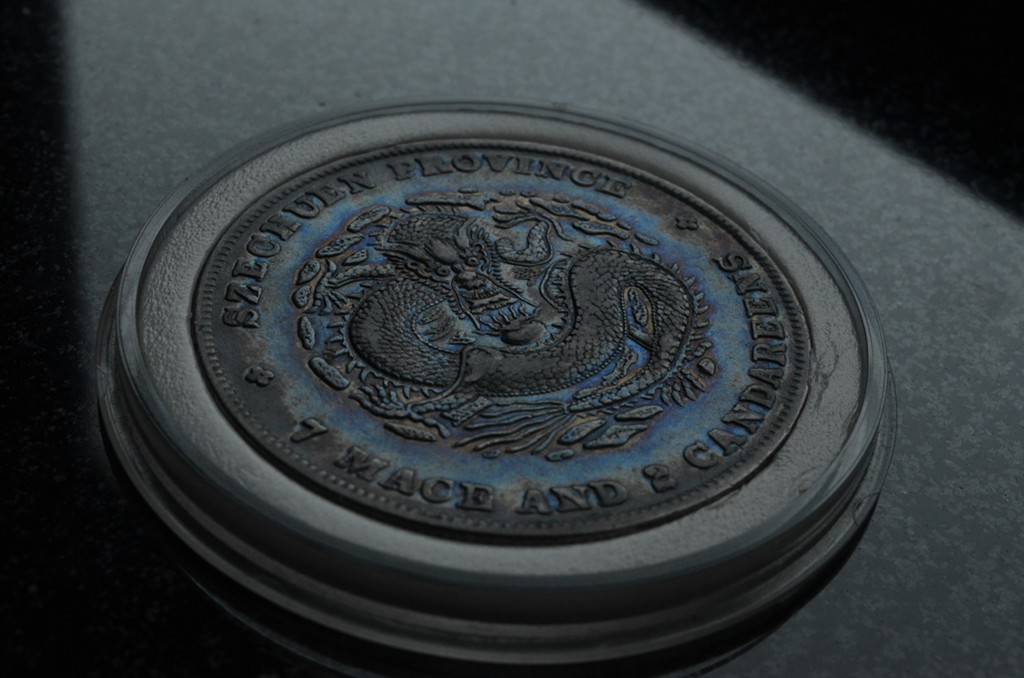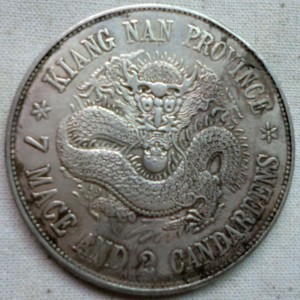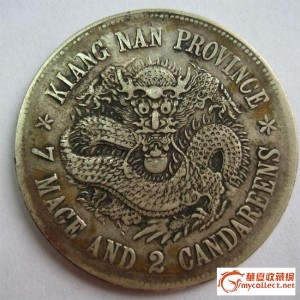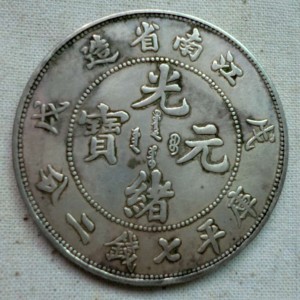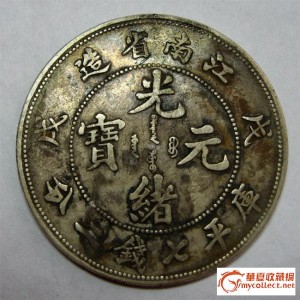In one of these internet message boards I frequent, a fellow Chinese coins collector produced pictures of a coin he had just bought from a dealer in Bangkok. I immediately identified a 英文大字珍珠龙: a nice variety of one of the most beautiful Chinese coins, the Kiang Nan dragon whose scales are ornate with pearls. This coin (often called “dragon with circlet-like scales” in English) was minted briefly in Nanjing at the beginning of the year 1898, before being replaced with a simpler design. There is several die varieties known, all very scarce.
Chinese characters on this particular variety are written with thicker strokes than usual, and the English legend is bolder as well. This concerned the new owner of this coin; did the unusual shape of the characters meant it was a forgery? I knew the design of the characters was normal, but finding a genuine 珍珠龙 (dragon with circlet-like scales) is a rare occurence, so the pictures still deserved a careful inspection.
The low resolution of the pictures didn’t allow me to get a good impression of the surface and relief of the coin. It looked like it had been dipped, but the details were convincing enough. The weight seemed a bit light (26.5 grams), but nothing egregious either. The picture of the edge was too blurry to be useful. At that point, I would have said it was a genuine, albeit badly cleaned coin. Nonetheless, something smelled fishy about it; something didn’t felt quite right, but for now I was unable to pinpoint it.
The next morning, higher resolution pictures were posted. Right upon looking at the edge, I knew the coin was fake. The reeding didn’t have the soft, rounded shape common to all the Kiang Nan silver dollars.
Now confident about the true nature of this coin, I had to announce the sad news to its owner: the case of the Bangkok pearls was closed. One day later, the Chinese coin collector posted a follow up. He had got confirmation from another coin dealer that the coin was indeed a forgery, and was able to return it for a refund. This case had a happy ending; not all do…
While american collectors put an emphasis on pristine coins, with “brilliant flashy mint state cartwheel luster” being an often seen eBay selling point for Morgan dollars, chinese collectors seem to like heavily toned or corroded coins. Why do chinese coins collectors like their coins “dirty”?
The reason is that chinese collectors don’t have the same relation with coins as their american peers.
Serious american collectors usually get their coins conserved, graded and hermetically slabbed, then store them securely in a bank vault or a safe. They don’t usually manipulate their coins, to avoid damaging them – they are actually fragile investment instruments. It is therefore important to get top grade, “problem free” coins to eventually sell them at an higher price than competing collectors with lower grade coins.
Chinese collectors most often store their coins in albums or coin capsules so they can be seen and touched, and won’t hesitate to test if a coin is genuine by making it ring against another silver coin (which will make the american collector wince). Chinese collectors value the link to the past that a coin represents – the many hands it went through, the many provinces it crossed from transaction to transaction. Manipulating the coin is just a continuation of its unique story, and therefore doesn’t decrease its appeal to chinese collectors.
It is therefore logical that toning is highly regarded in China: it is the outcome of a long aging process. Silver will naturally oxydize and react chemically to the substances it is exposed to, and depending of its alloy composition and environment, its colour will vary through a whole gamut of complex hues. A toned coin shows its history in the most vibrant way – its colourful surface is a unique, beautiful testimony of all the places and times it has gone through. That’s why it’s not treated as “filth” but respectfully called 包奖 (bao jiang).
A coin expert can tell from which part of China originates a toned, buried dollar. Soil composition varies in the different provinces, and it affects the chemical process accordingly: for example, silver yuan with a verdigris toning usually come from the South, and black coins from the Northern provinces. This adds to the narrative of the coin and makes it more attractive.
Since toning is such an aesthetic and desirable sign of old age, clever collectors or dealers have found out many creative ways to fake it. Methods range from the “organic”, like letting a coin bask in the sunlight on one’s window-sill or forget it in an enveloppe, to the somewhat gross (china ink, nose grease, cigarette smoke…) and the industrial (chemicals).
Most of these methods can be spotted – window-sill toning will make the coin surface look more dull, cigarette or chemicals usually leave the coin durably stinky. Artificial toning is designed to deceive buyers by dissimulating slight flaws (light cleaning, hairlines) or in the worst case hide retooling, harsh cleaning (acid prevents coins from toning) or as part of the artificial aging process for fake coins. Forgery is an industry in China, so artificial toning will almost always be chemical in that case.
Some black deposits around the legend or the rim of an otherwise white coin are an hallmark of fake chinese coins. If you look carefully, the residues usually look like some kind of paint or varnish. The surface of the coin is covered with this black substance, then it is washed to make it look like the surface of an old, cleaned coin. Some other coins are bathed in a chemical that leave the coin covered with verdigris like deposits, but unlike genuine buried silver dollars, such a forgery will actually reek of whatever was used to obtain this result.
The dust, corrosion and toning on a beautiful coin are aesthetic reminders of all the people who hold it before us and will hold it long after we are gone. For chinese collectors, feeling the weight of time in the palm of one’s hand is worth a premium.
